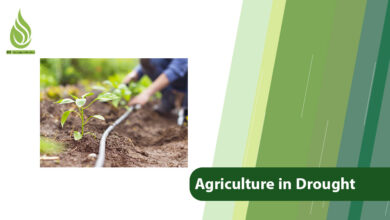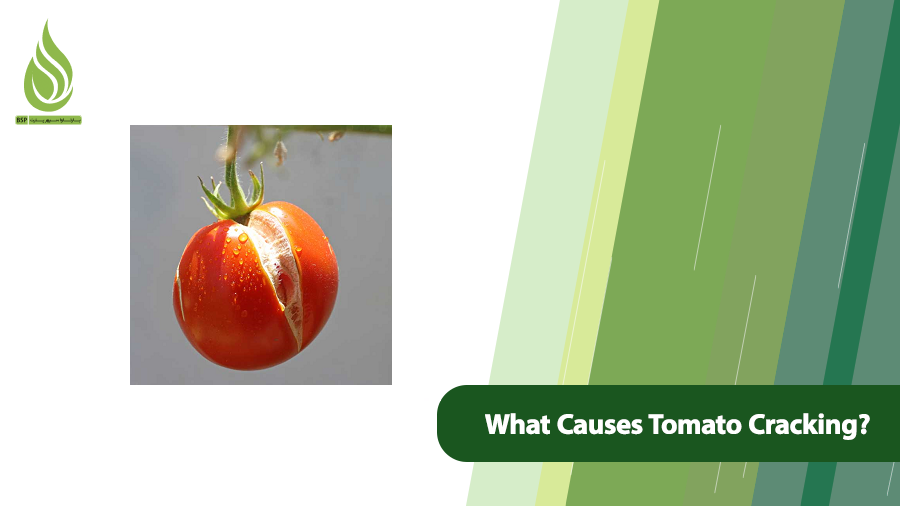
What Causes Tomato Cracking? Ways to Prevent It
Tomatoes are one of the most beloved and versatile vegetables (or fruits, if we’re being technical) in the world. They’re a staple in kitchens everywhere, from fresh salads and sandwiches to sauces, soups, and even juices. The average person consumes around 20 pounds of fresh tomatoes each year, and that’s not counting processed products like ketchup or pasta sauce. Globally, tomato production exceeds 180 million tons annually, making it a cornerstone of agriculture. But for gardeners, farmers, and even commercial growers, one frustrating issue can spoil the harvest: tomato cracking. This common problem not only affects the appearance of the fruit but also reduces its shelf life and market value. Cracked tomatoes are more prone to rot, pest invasions, and diseases, turning what should be a bountiful yield into a disappointment.
In this guide, we’ll dive deep into the causes of tomato cracking, exploring the science behind it and drawing from reliable agricultural research. We’ll also outline practical prevention strategies to help you grow flawless, juicy tomatoes. Whether you’re a backyard enthusiast or managing a larger operation, understanding these factors can make all the difference. By incorporating best practices like consistent watering, proper nutrition, and variety selection, you can minimize cracking and maximize your harvest. Let’s start by looking at the symptoms and then break down the root causes.
Symptoms of Tomato Cracking
Tomato cracking manifests as splits or fissures on the fruit’s skin, which can vary in severity. These cracks often appear during the early stages of fruit development, but can also occur as the tomatoes ripen. Vertical cracks typically start from the stem end or the blossom end and extend upward, while horizontal or circular cracks form rings around the fruit, resembling growth rings on a tree. Irregular cracks might scatter across the surface without a clear pattern.
In mild cases, you might see just a few small splits that don’t penetrate deeply. However, severe cracking can render the entire fruit unusable, as deep fissures expose the inner flesh to air, moisture, and contaminants. This not only ruins the aesthetic appeal, making the tomatoes less desirable for fresh markets, but also invites secondary issues. For instance, cracks can serve as entry points for insects like fruit flies or pathogens such as fungi and bacteria, leading to rot or diseases like anthracnose. According to extension services from North Carolina State University, cracking often coincides with rapid fruit expansion, exacerbating these vulnerabilities. If left unchecked, what begins as a cosmetic flaw can escalate into significant crop loss.
Beyond the visual signs, cracked tomatoes may feel softer or leak juices, and in extreme heat or humidity, they can develop a leathery texture around the splits. Gardeners in regions with unpredictable weather often report higher incidences during rainy spells following droughts. Recognizing these symptoms early allows for timely intervention, such as adjusting watering schedules or harvesting prematurely.
Defining Tomato Cracking
Tomato cracking is a physiological disorder, not a disease or pest infestation. It occurs when the fruit’s internal pressure builds faster than the skin can accommodate, causing it to rupture. This is akin to how a balloon might burst if inflated too quickly. Cracks usually emerge in the green or ripening stages, but they’re most noticeable on mature red fruits. There are three main types:
- Vertical Cracks: These run from the bottom (blossom end) upward, often linked to uneven growth.
- Circular or Concentric Cracks: These encircle the fruit near the stem, resembling onion rings, and are common in overwatered plants.
- Irregular Cracks: Random patterns across the skin, typically from multiple stressors combined.
Unlike issues caused by pathogens, cracking stems from environmental and cultural factors. Research from the University of Minnesota Extension highlights that it’s triggered by imbalances in water uptake, temperature swings, or nutrient deficiencies, rather than biological agents. By addressing these root causes, growers can prevent most instances, ensuring higher-quality yields.
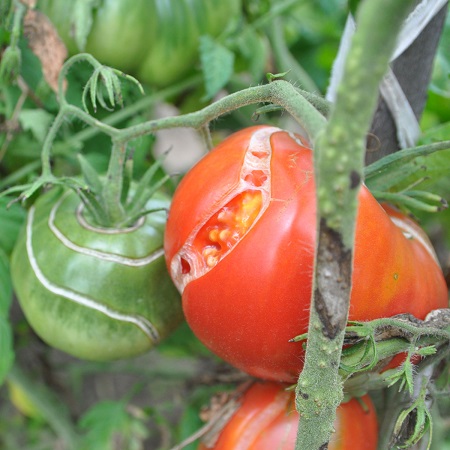
Reasons for Tomato Cracking and Control Methods
Several interconnected factors contribute to cracking, but the good news is that most are manageable with proactive care. Let’s explore each in detail, backed by insights from horticultural experts.
Fluctuations in Water Supply
One of the primary culprits behind tomato cracking is inconsistent watering. Tomatoes require steady moisture to thrive; about 1 to 2 inches per week, depending on climate and soil type. When plants experience drought followed by heavy watering or rain, the fruit absorbs water rapidly, swelling faster than the skin can stretch. This internal pressure leads to splits, much like overfilling a water balloon.
For example, after a dry spell, a sudden downpour can cause fruits to expand by up to 20% in volume overnight, according to studies from The Spruce. In commercial fields, this is exacerbated in sandy soils that drain quickly, leaving roots thirsty between irrigations.
Prevention Strategies:
- Establish a regular watering schedule: Aim for deep, infrequent sessions every 3-5 days in summer, ensuring water penetrates 6-8 inches into the soil. Drip irrigation is ideal, as it delivers moisture directly to roots without wetting foliage, reducing disease risk and evaporation loss. Rivulis, a leader in irrigation tech, notes that drip systems can cut water use by 30-50% while preventing cracks.
- Use mulch: Apply 2-4 inches of organic mulch like straw or pine needles around plants to retain soil moisture and suppress weeds. This maintains even humidity levels, buffering against dry periods.
- Monitor soil moisture: Tools like soil probes or simple finger tests (stick your finger 2 inches into the soil; if it’s dry, water) help avoid over- or under-watering. In greenhouses, automated sensors can fine-tune this further.
By maintaining consistent moisture, you prevent the “shock” that leads to cracking, promoting uniform growth.
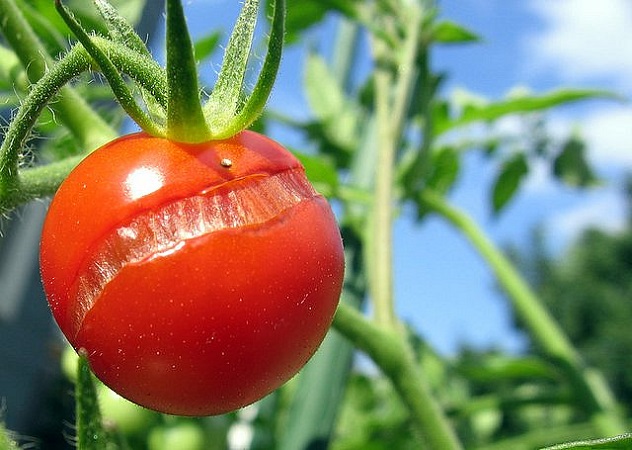
Rain After a Drought Period
In open fields, natural weather patterns amplify water fluctuations. A prolonged dry spell followed by heavy rain is a classic scenario for mass cracking. The parched soil and roots suddenly flood with water, causing fruits to bloat and split. Farmers in rain-fed areas often see entire crops affected after storms, with losses up to 30% in severe cases.
Prevention Strategies:
- Proactive harvesting: Pick fruits at the “breaker” stage (when they start changing color) before forecasted rain. Allow them to ripen indoors in a cool, dark place. This not only avoids cracking but extends shelf life.
- Improve drainage: Ensure fields have good tilth and avoid low-lying areas prone to flooding. Raised beds in home gardens elevate plants above excess water.
- Mulching again proves invaluable: It slows evaporation during droughts and absorbs excess rain, stabilizing soil moisture. Espoma Organic recommends combining mulch with weekly deep watering for best results.
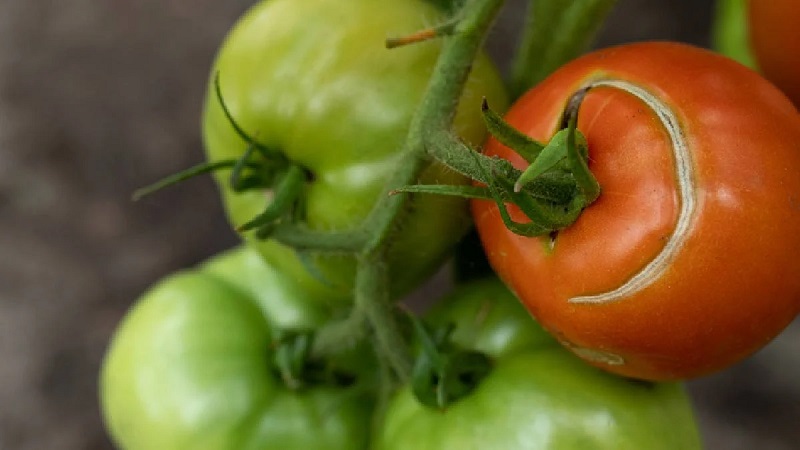
Improper Nutrition
Nutrition plays a starring role in fruit integrity. Deficiencies or excesses disrupt cell wall strength and growth rates.
- Calcium Deficiency: Calcium is crucial for building strong cell walls in the fruit skin. Low levels weaken the epidermis, making it prone to cracking under pressure. This often overlaps with blossom-end rot (BER), where the fruit’s bottom turns black and leathery. Yara explains that calcium transport relies on steady water flow; droughts interrupt this, starving the fruits. Soil tests often reveal deficiencies in acidic or sandy soils.
- Excessive Nitrogen: While nitrogen boosts leafy growth, too much leads to rapid, soft fruit development. Plants become “lush” with dark green foliage but produce fewer, more crack-prone tomatoes. University of California Davis warns that excess N delays maturity and increases susceptibility to disorders.
Prevention Strategies:
- Soil testing: Before planting, test for pH and nutrients. Amend with lime for low calcium or compost for organic matter.
- Balanced fertilization: Use tomato-specific fertilizers like 5-10-10, applying at planting and mid-season. Foliar sprays of calcium nitrate can address deficiencies quickly. Research from PMC shows that 0.9% calcium applications reduce cracking by boosting fruit strength.
- Avoid over-fertilizing: Limit nitrogen to 1-2 pounds per 100 square feet annually. Organic options like fish emulsion provide slow-release nutrients without overload.
Proper feeding ensures even growth, reducing the risk of splits. We suggest you take a look at our guide to tomato fertilization.
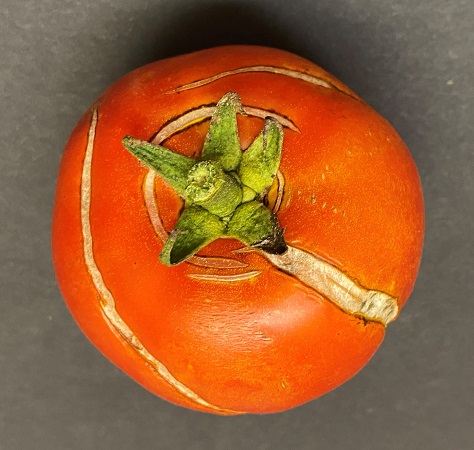
Temperature Fluctuations
Tomatoes prefer daytime temps of 70-85°F and nights above 55°F. Wide swings, hot days followed by cool nights, cause fruits to expand and contract, stressing the skin. High heat accelerates transpiration, dehydrating fruits, while sudden cools lock in moisture imbalances. A study from MDPI found that increased temperatures reduce fruit quality and yield by altering physicochemical traits. In late summer, when nights dip below 50°F, cracking spikes.
Prevention Strategies:
- Shade cloth: In hot climates, use 30-50% shade nets during peak sun to moderate temps.
- Mulch for insulation: It keeps soil cooler in heat and warmer at night.
- Site selection: Plant in protected areas away from wind, which exacerbates fluctuations. Greenhouses offer controlled environments for commercial growers.
Unsuitable Soil pH
Tomatoes thrive in slightly acidic soil with pH 6.2-6.8. Outside this, nutrient uptake suffers; low pH locks out calcium, while high pH ties up iron and manganese. Michigan State University research links low pH to higher cracking via reduced calcium availability. Alkaline soils in arid regions compound this.
Prevention Strategies:
- Adjust pH: Add sulfur to lower it or lime to raise it, based on tests. Organic matter like compost buffers pH naturally. You can also use ammonium sulfate fertilizer to do so.
- Regular monitoring: Annual tests keep levels optimal, ensuring max nutrient absorption for robust fruits.
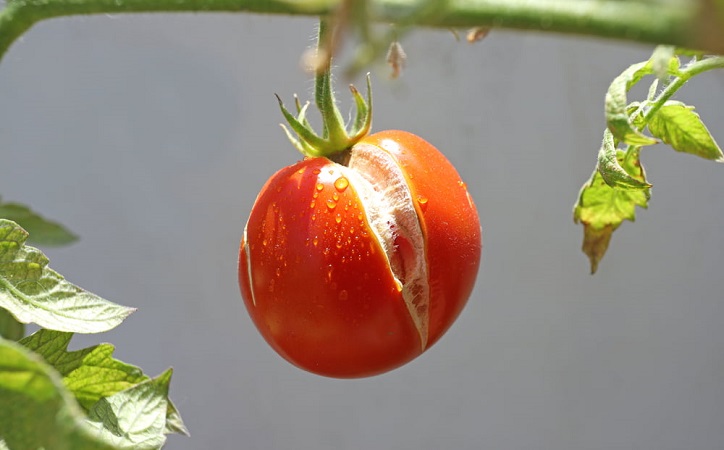
Tomato Variety Selection
Not all tomatoes are equal; some have thicker skins resistant to cracking. Thin-skinned heirlooms like Brandywine are vulnerable, while hybrids excel in tough conditions.
Prevention Strategies:
- Choose resistant varieties: Options include Celebrity (crack-resistant with heavy yields), SunSugar, Sweet Million, Black Sea Man, and Rebelski. Urban Farmer lists these as top performers. For blight resistance too, try Crimson Crush or Mountain Magic.
Intense Sunlight
Direct, scorching sun raises fruit temps, evaporating moisture and causing sunscald; white, papery patches that crack. Exposed fruits on sparse vines are hit hardest.
Prevention Strategies:
- Provide shade: Use row covers or plant companions like basil for natural cover.
- Timely harvest: Pick before full ripeness in hot spells. Prune judiciously to maintain leaf canopy.
Improper Use of Pesticides
High-concentration sprays can burn or stress skins, leading to cracks, especially in heat when residues concentrate.
Prevention Strategies:
- Follow labels: Use recommended dilutions and apply in cool hours (early morning or evening).
- Opt for organics: Neem oil or insecticidal soaps are gentler alternatives.
Are Cracked Tomatoes Safe to Eat?
Yes, most cracked tomatoes are edible if the splits are superficial and free of rot. Consume them quickly or process into sauces to avoid spoilage. Deep cracks may harbor bacteria, so inspect and discard affected parts. In summary, with vigilant care, cracking is preventable, yielding bountiful, beautiful tomatoes.
